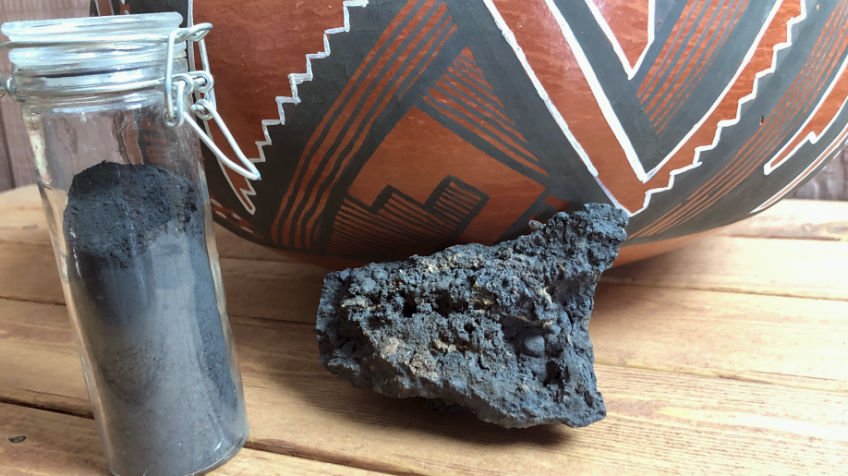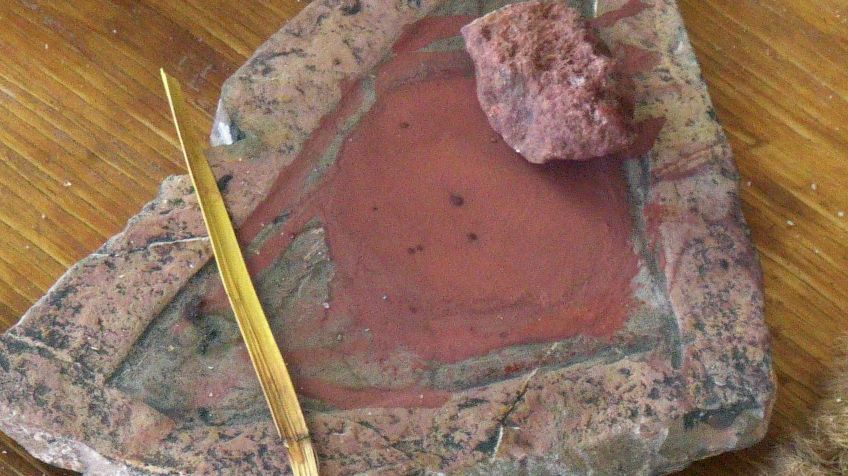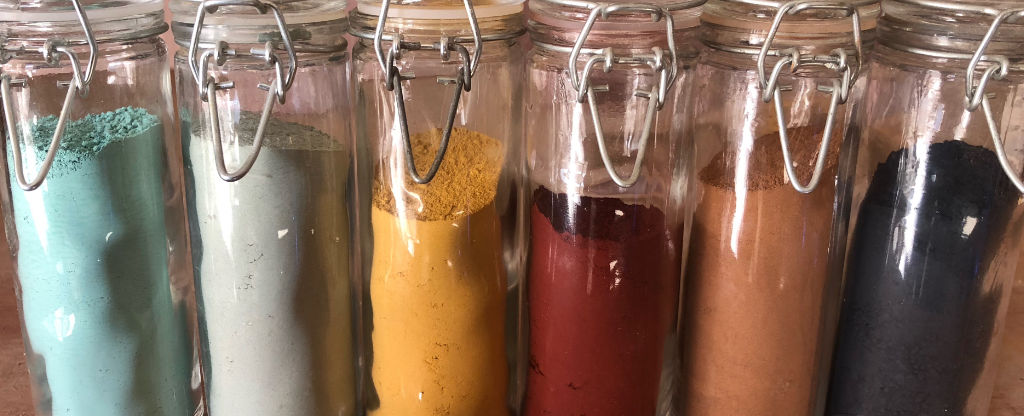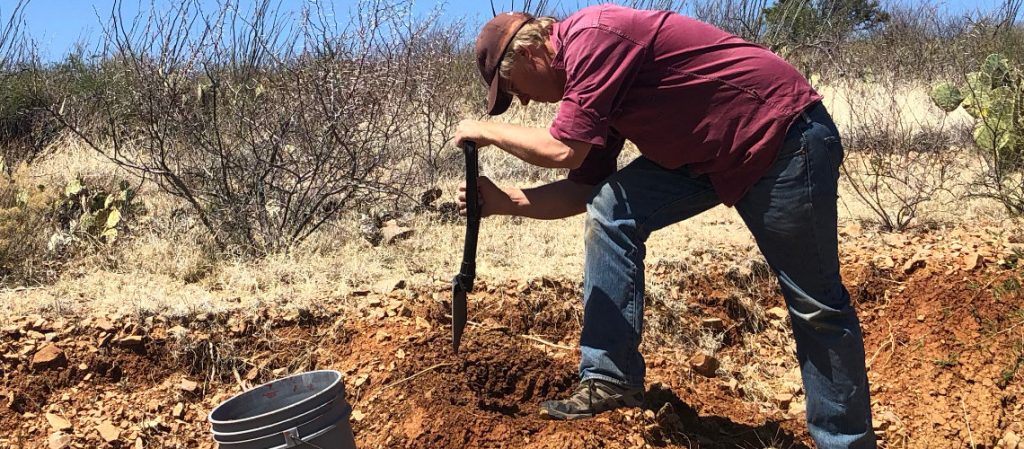A rainbow of colors are available to the primitive potter from natural sources. But what minerals to use in which type of firing to achieve what color can be confusing and overwhelming. In the following article I have broken it down to the basic elements. Paint information below is sorted by color and by mineral or ingredients so you should be able to easily find out what you need to achieve the type of pottery you are trying to produce.
COLORS

BLACK
- Manganese Dioxide
- Black in oxidation, sometimes brownish in reduction
- Copper Carbonate
- Black to grey, often with a red halo in oxidation.
- Iron Oxide
- Black in full reduction only
- Organic Paints
- Must be applied to a smectite clay slip and fired in a “limited oxidation” atmosphere. Over oxidation will result in grey, washed-out paint.
RED
- Iron Oxide
- Red in oxidation, colors can vary wildly with source, from purple to dark red, to bright candy apple red.
WHITE
- White or Grey Clay
- All white designs on prehistoric Southwestern pottery is derived from clay. Choose your source carefully as many white clays will come out of an oxidation fire tan, cream, buff or even yellow. Some grey clays will fire to a nice white.
YELLOW/ORANGE
- Clay
- Most yellow or orange colors on prehistoric pottery come from grey, green, cream or yellow colored clays in an oxidation fire.
- Yellow Iron Oxide (Limonite)
- Some yellow ochre may produce an orange color in an oxidation fire but careful testing of your mineral source is important as most yellow ochre will fire red.
UNNATURAL COLORS
- Blue, Green
- These colors cannot be achieved with natural materials which is why they are never found on prehistoric pottery. Copper carbonate minerals which naturally come in these colors will turn black or grey in a fire.
I have heard about some Mata Ortiz potters soaking copper pipes in white clay that will then absorb the minerals and turn green, the resulting material is said to keep its color in the firing. I have never tried this and there is some misinformation surrounding some Mata Ortiz pottery techniques so be cautious and please report your findings back here if you try it. - Purple
- Iron Oxide can sometimes be a little bit purplish but always more on the red side of that spectrum.
Ancient Trincheras Culture pottery paint is sometimes described as purple but it is really more of a glittery grey. This color is achieved through the use of Spectral Hematite as a paint source.

PAINT TYPES
Manganese Dioxide
Can make a good black in an oxidation fire. Sometimes it will turn a dark brownish color which can frustrate a potter looking for a good black. I have found some success in using a purer source of manganese and making sure my pottery fully oxidizes as even a slight amount of reduction can result in a more brownish color.
Manganese paint requires a fixative to make it harden in the firing.
Copper Carbonate
Makes a dark grey to black color in oxidation or reduction. In oxidation it will sometimes produce a bright red halo around the painted design.
Copper paint requires a fixative to make it harden in the firing.
Iron Oxide
Results in a red color in oxidation or can turn black in reduction. The shades of red can vary greatly from very dark red to a very bright red depending on the source. In my experience, the dark red hematite nodules stay dark after firing and can be almost brown in color post-firing. While the brightest red is the result of paint made from yellow limonite.
If it is fired hot enough (> 1000 C) some iron oxide paint will sinter, causing it to harden and stick to the pot without the use of a fixative.
Organic Paints
Organic pottery paint is the hardest to figure out and get right, but the easiest to make and use once you have the correct ingredients and firing process in place.
Organic paint can be made out of many different plants, boiled down into a thick syrup. Rocky Mountain Bee Plant is traditional in the Southwest but experiments with wild sunflowers, mesquite beans, yucca fruit and many other plants have proved successful.
Once produced these paints are applied over a slip of smectite clay (usually white or cream in color). The right clay is more critical than the paint. Using the wrong clay slip will result in the painted designs being burned away in the firing.
The final critical element is the correct firing regime. The oxidation phase needs to be very brief, long enough to clean up the surface of the pot but not so long that the paint starts to burn away. Generally this is achieved in one of two ways. One way is smothering the fire and pots in a trench kiln with earth and the other is to start pulling the fuel away from the pots once it reaches the correct amount of oxidation.
Clays
Many of the beautiful colors found on Southwestern pottery are merely the result of unique and colorful clays. Almost every color in the “warm” part of the spectrum, from white through yellow and orange to reds and browns can be achieved through natural clays. Even black can be achieved if the clay is smudged during the firing process.
The next time you are on a drive in the country, keep an eye out for clays that you can collect and try. Before long you may have a large selection of sumptuous colors to choose from.

PAINT RECIPES
The above information is meant to help you figure out which material can be used to produce the desired color. If you are looking for more detailed information such as; paint recipes, how to make organic paint, how much organic binder to use, etc, then check out my online masterclass Natural Pottery Paints, Slips & Pigments. This class will teach you everything you need to know about making your own pottery paint from natural materials.




Can I buy the Clay slip that turns white. Would like to swap my pure iron oxide which comes from the water treatment of coal mine drainage. This pure “yellow-boy” turns reddish when heated and is sold to manufacturers to use as pigment in cement stone/blocks used in landscaping…. contact me for a swap
Hey Malcolm. I sell some white slip ion my website here https://ancientpottery.how/product/smectite-clay-slip-for-organic-painted-pottery/ the swapo sounds interesting but I am not interested as I already have a lot of clays and pigments. Maybe try posting this request on my Facebook “Primitive Pottery” group https://www.facebook.com/groups/SWpottery
Hi Andy… I did come across blue paint in specimens of ancient Baluchistan pottery. I understand it’s a lost and complex recipe. Ancient pottery from Indus Valley civilization is breathtaking, just like the ancient South West pottery.
Here is a link to Khavda pottery still being made by a family in Khavda village in Kutch, which too may die of neglect soon. For black, they seem to use a mineral color and use India mesquite thorns and branches to cover and smoulder trench fire (I wonder how and why that works). You are experienced here and might be able to figure out their technique for smoky grey-black paint here. If you do, pray share. Thanks.
Thank you Ranu, this is fascinating. If someone were to write down all the knowledge of all the traditional potters in this world, there wouldn’t be enough paper to hold it all. It is important to keep these traditions alive. Please people, support traditional artists!
https://cultureandheritage.org/2020/01/awe-inspiring-khavda-pottery-of-gujarat-in-west-india.html
Hey. Wouldn’t mineral stones like lapis lazuli work if used correctly? In advance response much appreciated.